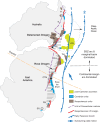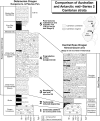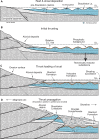Tectonic trigger to the first major extinction of the Phanerozoic: The early Cambrian Sinsk event
- PMID: 38552008
- PMCID: PMC10980278
- DOI: 10.1126/sciadv.adl3452
Tectonic trigger to the first major extinction of the Phanerozoic: The early Cambrian Sinsk event
Abstract
The Cambrian explosion, one of the most consequential biological revolutions in Earth history, occurred in two phases separated by the Sinsk event, the first major extinction of the Phanerozoic. Trilobite fossil data show that Series 2 strata in the Ross Orogen, Antarctica, and Delamerian Orogen, Australia, record nearly identical and synchronous tectono-sedimentary shifts marking the Sinsk event. These resulted from an abrupt pulse of contractional supracrustal deformation on both continents during the Pararaia janeae trilobite Zone. The Sinsk event extinction was triggered by initial Ross/Delamerian supracrustal contraction along the edge of Gondwana, which caused a cascading series of geodynamic, paleoenvironmental, and biotic changes, including (i) loss of shallow marine carbonate habitats along the Gondwanan margin; (ii) tectonic transformation to extensional tectonics within the Gondwanan interior; (iii) extrusion of the Kalkarindji large igneous province; (iv) release of large volumes of volcanic gasses; and (v) rapid climatic change, including incursions of marine anoxic waters and collapse of shallow marine ecosystems.
Figures






Similar articles
-
Hydroids (Cnidaria, Hydrozoa) from Mauritanian Coral Mounds.Zootaxa. 2020 Nov 16;4878(3):zootaxa.4878.3.2. doi: 10.11646/zootaxa.4878.3.2. Zootaxa. 2020. PMID: 33311142
-
The two phases of the Cambrian Explosion.Sci Rep. 2018 Nov 9;8(1):16656. doi: 10.1038/s41598-018-34962-y. Sci Rep. 2018. PMID: 30413739 Free PMC article.
-
Theory and classification of mass extinction causation.Natl Sci Rev. 2023 Sep 8;11(1):nwad237. doi: 10.1093/nsr/nwad237. eCollection 2024 Jan. Natl Sci Rev. 2023. PMID: 38116094 Free PMC article. Review.
-
Formation of the 'Great Unconformity' as a trigger for the Cambrian explosion.Nature. 2012 Apr 18;484(7394):363-6. doi: 10.1038/nature10969. Nature. 2012. PMID: 22517163
-
Orogen styles in the East African Orogen: A review of the Neoproterozoic to Cambrian tectonic evolution.J Afr Earth Sci. 2013 Oct;86:65-106. doi: 10.1016/j.jafrearsci.2013.06.004. J Afr Earth Sci. 2013. PMID: 27065752 Free PMC article. Review.
Cited by
-
The Emu Bay Shale: A unique early Cambrian Lagerstätte from a tectonically active basin.Sci Adv. 2024 Jul 26;10(30):eadp2650. doi: 10.1126/sciadv.adp2650. Epub 2024 Jul 26. Sci Adv. 2024. PMID: 39058778 Free PMC article.
References
-
- Zhuravlev A. Y., Wood R. A., Anoxia as the cause of the mid-Early Cambrian (Botomian) extinction event. Geology 24, 311–314 (1996).
-
- Cawood P. A., Strachan R. A., Pisarevsky S. A., Gladkochub D. P., Murphy J. B., Linking collisional and accretionary orogens during Rodinia assembly and breakup: Implications for models of supercontinent cycles. Earth Planet. Sci. Lett. 449, 118–126 (2016).
LinkOut - more resources
Full Text Sources


